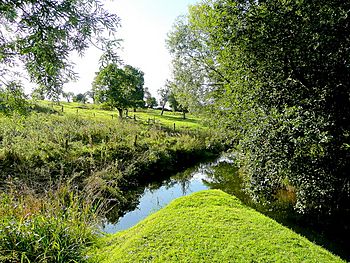River Isbourne facts for kids
Quick facts for kids River Isbourne |
|
|---|---|

River Isbourne near Hinton-on-the-Green
|
|
| Country | United Kingdom |
| Country within the UK | England |
| Counties | Gloucestershire, Worcestershire |
| Towns | Winchcombe, Evesham |
| Physical characteristics | |
| Main source | Cleeve Hill Cotswolds, Gloucestershire 51°56′05″N 2°00′26″W / 51.9346°N 2.0072°W |
| River mouth | Confluence with the Avon Hampton, Worcestershire 52°05′10″N 1°57′23″W / 52.0862°N 1.9564°W |
| Length | 22 km (14 mi) |
| Basin features | |
| Basin size | 95 km2 (37 sq mi) |
| Tributaries |
|
The River Isbourne is a cool river in England. It flows for about 14 miles (22 km) through two counties, Gloucestershire and Worcestershire. This river is a branch, or "tributary," of the larger River Avon.
Contents
What is the River Isbourne's Journey?
The River Isbourne starts its journey from several springs. These springs are found on the northern side of Cleeve Hill. This area is part of the beautiful Cotswold Hills.
From Hills to Towns
The river flows down from Cleeve Hill in a valley. It heads north through a tiny village called Postlip. Next, it reaches the town of Winchcombe, flowing along its eastern edge.
After Winchcombe, the Isbourne continues north. It passes through Toddington and the grounds of Toddington Manor. Then it goes past the village of Wormington.
Crossing Counties and Joining Other Waters
The river then crosses into Worcestershire. Here, another small stream called the Laverton Brook joins it. The Isbourne then reaches the village of Sedgeberrow.
Continuing directly north, the river flows through Hinton-on-the-Green. Finally, it passes through some market gardens on the edge of Evesham. It goes under the Pershore road before joining the River Avon near Hampton.
What Area Does the River Isbourne Cover?
The area that collects water for the River Isbourne is called its "catchment." This area covers about 95 square kilometers (37 square miles). It's located between other streams and hills.
Rainfall in the Catchment Area
The Isbourne catchment gets about 704 millimeters (28 inches) of rain each year. This is a bit less rain than the average for all of England, which is about 828 millimeters (33 inches).
How Land is Used Around the River
Most of the land in the catchment area is rural. About 80 percent of it is used for farming, like growing crops or raising animals. The rest is mostly woodland, with only a tiny bit of urban area (less than 2 percent).
River Isbourne and its Geology
The ground under the Isbourne catchment is mostly made of a type of clay called Lias clay. This clay doesn't let water soak in easily. This means that when there's heavy rain, the Isbourne can rise quickly and cause floods.
Has the River Isbourne Flooded Before?
The River Isbourne has flooded many times in the past. Places along its path, especially Sedgeberrow, have experienced floods.
The 2007 Floods
One of the most recent big floods happened in the summer of 2007. This event caused damage, like to the road bridge near Hinton-on-the-Green.


